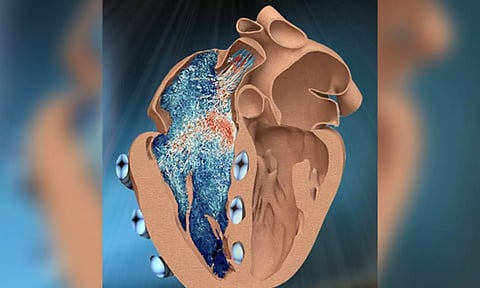

NEW YORK: A team of US engineers, led by one of an Indian-origin, has developed a robotic replica of the heart's right ventricle, which mimics the beating and blood-pumping action of live hearts.
The realistic model developed by a team at Massachusetts Institute of Technology (MIT) can aid the development of better heart implants and shed light on understudied heart disorders.
The right ventricle is one of the heart’s four chambers, along with the left ventricle and the left and right atria. Of the four chambers, the left ventricle is the heavy lifter, as its thick, cone-shaped musculature is built for pumping blood through the entire body.
“The right ventricle is particularly susceptible to dysfunction in intensive care unit settings, especially in patients on mechanical ventilation,” said Manisha Singh, a postdoc at MIT’s Institute for Medical Engineering and Science (IMES).
“The robotic right ventricle (RRV) simulator can be used in the future to study the effects of mechanical ventilation on the right ventricle and to develop strategies to prevent right heart failure in these vulnerable patients,” she added.
In the paper, appearing in the journal Nature Cardiovascular Research, the team described a model that includes real heart tissue, explanted from a pig’s right ventricle which was treated. The team then fit a silicone wrapping around it, which acted as a soft, synthetic myocardium, or muscular lining.
Within this lining, the team embedded several long, balloon-like tubes, which encircled the real heart tissue, in positions that the team determined through computational modelling to be optimal for reproducing the ventricle’s contractions.
The researchers connected each tube to a control system, which they then set to inflate and deflate each tube at rates that mimicked the heart’s real rhythm and motion.
“Conventional tools often fail to capture the intricate mechanics and dynamics of the right ventricle, leading to potential misdiagnoses and inadequate treatment strategies,” Singh said.
The artificial ventricle can be tuned to mimic healthy and diseased states. The team manipulated the model to simulate conditions of right ventricular dysfunction, including pulmonary hypertension and myocardial infarction. They also used the model to test cardiac devices.
For instance, the team implanted a mechanical valve to repair a natural malfunctioning valve, then observed how the ventricle’s pumping changed in response.
The team said the new robotic right ventricle, or RRV, can be used as a realistic platform to study right ventricle disorders and test devices and therapies aimed at treating those disorders.